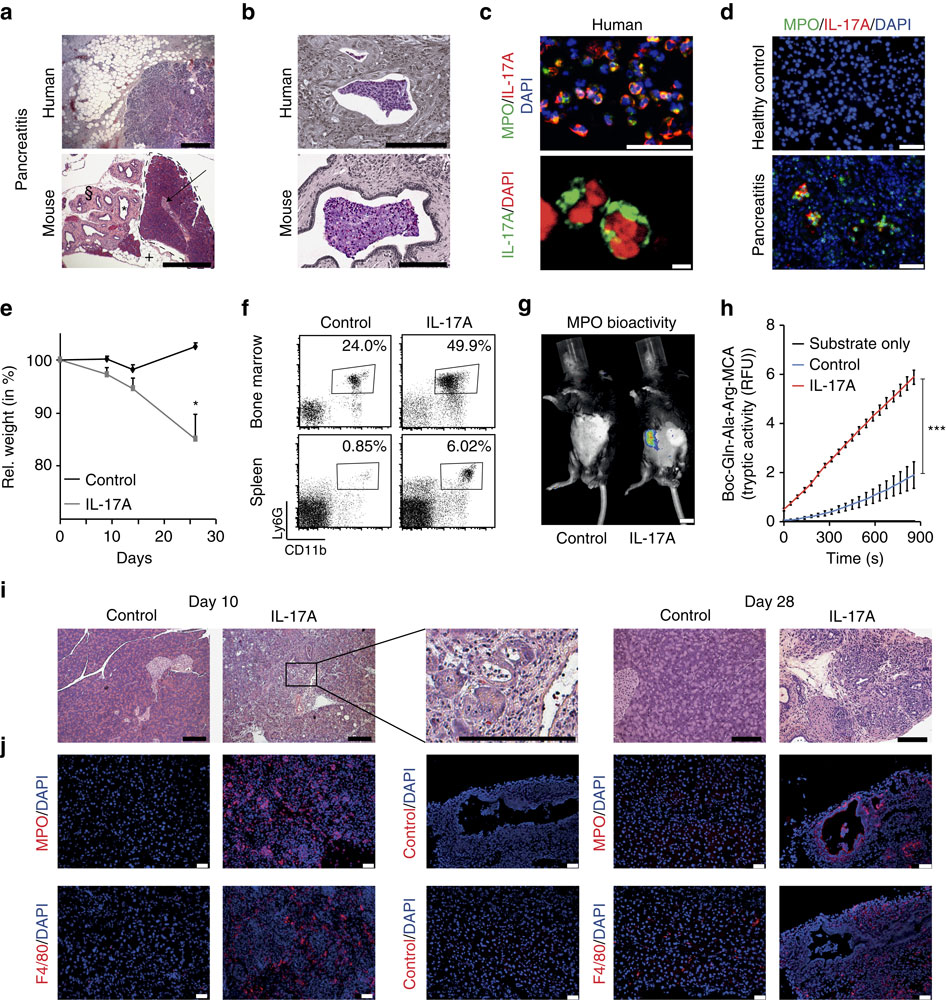当前位置:
X-MOL 学术
›
Nat. Commun.
›
论文详情
Our official English website, www.x-mol.net, welcomes your
feedback! (Note: you will need to create a separate account there.)
Externalized decondensed neutrophil chromatin occludes pancreatic ducts and drives pancreatitis.
Nature Communications ( IF 14.7 ) Pub Date : 2016-Mar-11 , DOI: 10.1038/ncomms10973
Moritz Leppkes , Christian Maueröder , Sebastian Hirth , Stefanie Nowecki , Claudia Günther , Ulrike Billmeier , Susanne Paulus , Mona Biermann , Luis E. Munoz , Markus Hoffmann , Dane Wildner , Andrew L. Croxford , Ari Waisman , Kerri Mowen , Dieter E. Jenne , Veit Krenn , Julia Mayerle , Markus M. Lerch , Georg Schett , Stefan Wirtz , Markus F. Neurath , Martin Herrmann , Christoph Becker
Nature Communications ( IF 14.7 ) Pub Date : 2016-Mar-11 , DOI: 10.1038/ncomms10973
Moritz Leppkes , Christian Maueröder , Sebastian Hirth , Stefanie Nowecki , Claudia Günther , Ulrike Billmeier , Susanne Paulus , Mona Biermann , Luis E. Munoz , Markus Hoffmann , Dane Wildner , Andrew L. Croxford , Ari Waisman , Kerri Mowen , Dieter E. Jenne , Veit Krenn , Julia Mayerle , Markus M. Lerch , Georg Schett , Stefan Wirtz , Markus F. Neurath , Martin Herrmann , Christoph Becker

|
Ductal occlusion has been postulated to precipitate focal pancreatic inflammation, while the nature of the primary occluding agents has remained elusive. Neutrophils make use of histone citrullination by peptidyl arginine deiminase-4 (PADI4) in contact to particulate agents to extrude decondensed chromatin as neutrophil extracellular traps (NETs). In high cellular density, NETs form macroscopically visible aggregates. Here we show that such aggregates form inside pancreatic ducts in humans and mice occluding pancreatic ducts and thereby driving pancreatic inflammation. Experimental models indicate that PADI4 is critical for intraductal aggregate formation and that PADI4-deficiency abrogates disease progression. Mechanistically, we identify the pancreatic juice as a strong instigator of neutrophil chromatin extrusion. Characteristic single components of pancreatic juice, such as bicarbonate ions and calcium carbonate crystals, induce aggregated NET formation. Ductal occlusion by aggregated NETs emerges as a pathomechanism with relevance in a plethora of inflammatory conditions involving secretory ducts.
中文翻译:

外部化的浓缩的嗜中性粒细胞染色质阻塞胰管并驱动胰腺炎。
假定导管阻塞会引起局灶性胰腺炎症,而主要阻塞剂的性质仍然难以捉摸。中性粒细胞利用肽基精氨酸脱亚氨酶-4(PADI4)与颗粒剂接触而形成的组蛋白瓜氨酸化,以将脱色的染色质挤出为中性粒细胞胞外捕获物(NETs)。在高细胞密度下,NET形成了肉眼可见的聚集体。在这里,我们显示了这种聚集物在人和小鼠的胰管内部形成,从而阻塞了胰管,从而驱动了胰腺炎症。实验模型表明,PADI4对于导管内聚集物形成至关重要,而PADI4缺乏则可阻止疾病进展。从机理上讲,我们将胰液确定为嗜中性粒细胞染色质挤出的强力推动者。胰液的特征性单一成分(例如碳酸氢根离子和碳酸钙晶体)诱导聚集的NET形成。聚集的NETs引起的导管阻塞是一种病理机制,与涉及分泌管的多种炎症有关。
更新日期:2016-03-14
中文翻译:

外部化的浓缩的嗜中性粒细胞染色质阻塞胰管并驱动胰腺炎。
假定导管阻塞会引起局灶性胰腺炎症,而主要阻塞剂的性质仍然难以捉摸。中性粒细胞利用肽基精氨酸脱亚氨酶-4(PADI4)与颗粒剂接触而形成的组蛋白瓜氨酸化,以将脱色的染色质挤出为中性粒细胞胞外捕获物(NETs)。在高细胞密度下,NET形成了肉眼可见的聚集体。在这里,我们显示了这种聚集物在人和小鼠的胰管内部形成,从而阻塞了胰管,从而驱动了胰腺炎症。实验模型表明,PADI4对于导管内聚集物形成至关重要,而PADI4缺乏则可阻止疾病进展。从机理上讲,我们将胰液确定为嗜中性粒细胞染色质挤出的强力推动者。胰液的特征性单一成分(例如碳酸氢根离子和碳酸钙晶体)诱导聚集的NET形成。聚集的NETs引起的导管阻塞是一种病理机制,与涉及分泌管的多种炎症有关。































 京公网安备 11010802027423号
京公网安备 11010802027423号